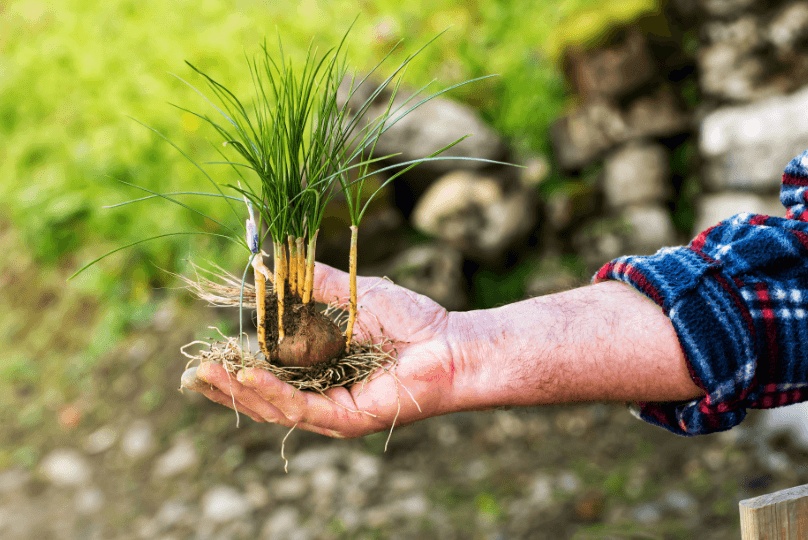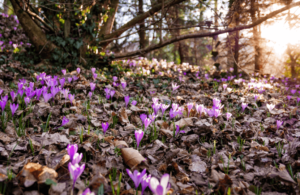Saffron prefers light friable soils with good drainage and they like warm dry summers and cold winters with good frosts. Corms can be grown in raised beds to improve drainage.
Plant corms in January to February. Place 10cm apart and 10cm deep in raised beds for increased drainage.
Depending on the size of the mother corm each corm can produce an average of six new corms in its second year.
Beds should be kept weed-free and to help control weeds between Saffron beds you can use sawdust but make sure the timber has not been treated with chemicals.
| Propagation: | Saffron bulbs can be planted in spring. |
| Yields/ha: | Somewhere between 70,000 and 200,000 flowers to produce 1kg of Saffron. This equates to 6–20kg/ha |
| Harvest: | March/April sometimes even into May on cold sites. |
| Soil type: | Free draining; best to grow the crop on raised beds. |
| Fertilisers: | General fertiliser. |
| Weed control: | Perennial weeds such as clover are a problem in beds. Herbicides can be used when the crop is dormant but care must be taken. A desiccant spray is better to use in this situation rather than a hormonal spray. |
| Pest/Diseases: | No obvious diseases have been observed on the Crops for Southland bulbs but watch for rots on bulbs being grown on slightly wetter ground. Rabbits have been known to dig up the bulbs and chew on the foliage. Rabbit netting around the outside of a block is an effective control. |
| Harvesting: | Harvest means bending down a lot. Flowers are picked daily, removing those just about to open. They should be chilled until they can be processed and the stamens removed. Stamens then need to be dried. |
Saffron Crocus (Crocus sativus) create quick jewel-toned flowers in the fall garden in about 6-10 weeks (sometimes as little as 4-6 weeks) after being planted. They can be planted in the garden in zones 6-10 or can be used in containers on a patio or grown indoors. Saffron Crocus can be harvested and dried to add flavor to your favorite dishes. Here are tips for growing Saffron Crocus.
Growing Saffron Crocus: When To Plant Saffron Crocus Bulbs
Make sure to plant Saffron Crocus bulbs at least 6 weeks before chance of frost. The bulbs (corms) don’t store well and should be planted soon after you receive them.
August is the best time to plant in colder locations (zones 3-6). Saffron Crocus are not cold hardy in zones 3-6, so you should plant the bulbs in a container that will be brought indoors before the chance of frost. If mulched well, Saffron Crocus can be winter hardy in zone 6.
September is best for planting in warmer locations (zones 7-10). Saffron Crocus can be planting in the ground or in containers in these warmer zones.
Where To Plant Saffron Crocus Bulbs
Plant in well-draining soil in sun to part shade. Make sure the bulbs will receive sun during bloom time. If bulbs stay in damp soil, such as clay, they could rot.
When To Expect Saffron Crocus To Bloom
Expect blooms in 6-10 weeks, though sometimes they’ll bloom in as little as 4-6 weeks. Crocus reach 4” tall at maturity.
Growing Saffron Crocus: Basic Planting Steps
Step 1: Plant bulbs as soon as possible after receiving them.
Step 2: Decide on a planting style:
A: Plant crocus bulbs close together to form a cluster, this technique creates a full showy colorful display. Space 12 bulbs per square foot.
B: For a more natural look, plant crocus bulbs speckled throughout a garden, or under trees.
C: Plant in a container with well-draining soil.
Step 3: To plant, dig a hole 2-4” deep for each bulb. Plant bulb pointy side up. If the crocus bulbs are being planted in poor soil conditions, add a layer of organic compost, bone meal or Yum Yum Mix around the crocus bulbs. Back-fill with soil and water thoroughly to remove air pockets.
How To Harvest Saffron*
When the flowers first bloom, remove the bright red stigmas in each flower’s center, as they carry the Saffron spice. You can use it in the fresh form, or dry it for later use. To dry your Saffron, spread the red stigmas out for several days on a paper towel in a warm, dry place. Once they are dry, store them in an air tight container in a cool dark place. (*Check with your physician before using Saffron in high doses or as a regular dietary supplement.)
Growing Saffron Crocus: Aftercare
Once blooms have passed and the leaves have turned yellow and brown, you can clean up the foliage. Pull gently on the leaves, if it comes away easily from the ground, the bulb has received all its nutrients. If the foliage seems hard to pull away, then the foliage isn’t ready to be removed yet.
Growing and Harvesting Saffron Crocus
Saffron is a delicious and colorful seasoning that is used in breads, desserts, and main dishes in many parts of the world, from England to India, from the Middle East to Scandinavia, and all around the Mediterranean. Without it, an Indian curry or a Spanish paella just wouldn’t be the same.
The bright red-orange threads you get when you buy saffron are actually the stigmas, or female portion, of the Saffron Crocus flowers. It takes hundreds of flowers to produce a commercially useful amount, which explains why saffron is so expensive. For the home gardener, however, two dozen Saffron Crocus will supply enough of the precious spice in the first year for a few memorable dishes. Then, with each successive year, the corms (which look like bulbs) will multiply, the size of the planting will increase, and you’ll be able to harvest more of the spicy stigmas. After 4 to 6 years, you should divide and replant the corms (do it right after the foliage has faded). Division prevents overcrowding, which can lead to a decrease in flowering.
Planting Saffron Crocus Corms: In areas where Saffron Crocus are reliably hardy—USDA Zone 6 through 8 in the South, 6 through 9 in the West—you should plant the corms as soon as you receive them. Saffron Crocus do best in full sun and well-drained soil that is moderately rich in organic matter. Ideally, the site should be relatively dry in summer, when the corms are dormant.
Plant the corms 4in deep and 4in apart. If gophers, mice, or voles are a problem in your garden, plant the corms in containers or line the bed with hardware cloth or a similar wire mesh. Flowers generally come up 6-8 weeks after planting, although occasionally they wait until the 2nd fall to appear. Bloom lasts about 3 weeks. The grass-like leaves may emerge either with the flowers or soon after they appear. Sometimes they wait until the following spring. In either case, the leaves persist for 8-12 weeks, then wither and vanish, leaving no trace of the corms below until the flowers appear again in fall. It’s not a bad idea to mark the area where you’ve planted your corms, so you don’t inadvertently dig them up while planting something else.
Overwintering Corms in Cold Climates: Saffron Crocus can be grown in areas with colder winters than Zone 6, but the corms must be lifted and brought indoors for the winter. After the first few frosts, but before the ground has frozen solid, carefully dig out the corms, place them in a wooden crate or plastic tub, and completely cover with dry peat moss or sand. Store in a cool (40-50°F), dry place, such as a basement. Plant them out again in the spring after all danger of frost has passed, but don’t water until you see new growth in early autumn.
Another way of growing Saffron Crocus in cold-winter areas is to plant the corms 2 in. deep in clay or plastic pots filled with a well-drained soil mix, and then set the pots directly in the ground, with the rims about 2 inches below the soil surface, so the pots don’t show. After the plants die back in the fall, move the pots into the basement and store them dry for the winter. Set the pots back out the following spring. Again, marking the pots’ location so you don’t accidentally dig into them is probably a good idea.
Harvesting and Using Saffron: Three stigmas are borne in the center of each purple, cup-shaped bloom. The best time to harvest the stigmas is mid-morning on a sunny day when the flowers have fully opened and are still fresh. Carefully pluck the stigmas from the flowers with your fingers, then dry them in a warm place to preserve them for cooking. Store in a closed container. To use saffron, steep the threads in hot liquid (water, broth, or milk, depending on the recipe) for about 20 minutes. Add both the threads and the steeping liquid early in the cooking or baking process, and the threads will continue to release their color and flavor.
Preparation
If planting in bulk plant in beds 50cm wide with paths of 50cm. A path ensures easier harvest; this path can be mulched with sawdust if desired, this also helps to distinguish where you have planted the saffron which is not always visible. Dig beds to a depth of 15-20cm and incorporate Oderings Compost into the soil. Fertilise beds after planting the bulbs and again in January/February. You can use Tui Bulb fertiliser, but if you want to get more specific use this magic combination.
Rock phosphate 2 parts for root growth, Dolomite 1 part for source of magnesium, Lime 1 part to raise the pH of the soil (saffron likes a neutral soil), Gypsum 1 part as a clay breaker and soil conditioner with a source of potassium as ¼ part for enhanced flower production. Please note, although some nitrogen is necessary for plant health and growth any excess will contribute to leaf production at the expense of flower production.
Planting
Corms are planted 10cm deep, 10cm apart. Water in with a liquid fertiliser containing seaweed and fish emulsion and trichoderma. A new product called ‘Fish & Seaweed Growth Booster’ by Egmont’s Commercial has all three of these ingredients and is 100% natural. This product is an essential part of your saffron maintenance. Trichoderma is specially formulated to act as a living barrier against damping off and root rots, while boosting the resilience and strength of the plants own immune system.
Harvesting
Flowers and leaves can appear from the last week of March to first week of May over a four week period. The start and end of flowering will vary slightly every year, which is brought on by the first rains towards the end of March. Generally, however, the harvesting season is through April. Flowers need to be picked every morning as early as possible. Flowers not picked on the day of flowering will usually have deteriorated to a point of non-usability by the 2nd morning after flowering.
Flowers that are proud off the ground and showing a part of stem can be picked. Use your thumb and first finger and slightly twist, or can nip with finger nails. Leave flowers that have not completely emerged for an hour or two before picking later in the day. Pick the flowers and place them in dry sanitised buckets with a paper towel at the bottom to absorb moisture and keep the flowers dry. Flowers will keep in the fridge or chiller once picked for up to three days.
Each corm can produce up to 6 flowers over the flowering period. The amount of flowers increases each season for a number of years, and then decreases as the corms get overcrowded and compete for nutrition. These corms should be dug up every three to four years and re-planted.
Flower Processing
Once picking is complete for the day, process flowers by removing the stigma (which is the part of the flower traded commercially). Flowers are placed on a flat covered surface.
The flower has three parts; the petals which are purple, the stamen which is yellow and the stigma which is orange to maroon (and has three prongs). The stigmas are removed a variety of ways. Generally its easiest to hold the stigma with the fingers of your left hand and pinch the bottom of the flower with the finger nails of your right hand, (and the flower falls to pieces) leaving the stigma in the left hand which is then placed on a the drying tray in a straight position. Stigmas are dried for 2 hours at 65c in a dehydrator. Remove from the dehydrator and store in an airtight container.
After Care of the Plants
When the flowering season is complete the saffron plants will now only have leaves which look like a type of grass. It is important to keep up fertilisation during autumn and winter to build your flowers for next year and to increase the amount of corms.
During the growing season and after flowering use ‘Fish & Seaweed Growth Booster’ every two weeks. Stop fertilising in October as the plants go dormant in anticipation for the summer.







